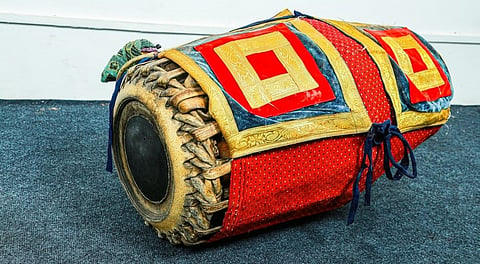
- Destinations
- Experiences
- Stay
- What's new
- Celebrating People
- Responsible Tourism
- CampaignsCampaigns
- Subscribe
- Buy Now

Said to have been invented in the 13th century, the Palakkad maddalam is considered a divine percussion instrument. This is on account of the sound of Om that emanates from it when struck. And also because it is said to have been included in the dance of Shiva. Now with a Geographical Indicator (GI) tag, the maddalam of Palakkad, Kerala, is better positioned to replicate and spread the sonic boom of passionate energy across the world.
Under Pressure
The maddalam is an anavadha vadya or a percussion instrument integral to dance and music art forms such as the Keli, Panchavadyam, Kathakali, and Krishnanattam. It is differentiated from the mridangam by the absence of the projection in the centre of the drum. The name of the drum, maddalam, is a colloquialism of the Sanskrit word mardhalam, or the one which receives pressure. Made from animal leather and indigenous wood, such as karingally, chempakkam, and jackwood, skilled craftsmen stretch the leather tight and bind it to the wood strips. This is done with the help of a paste of boiled rice and charcoal called choriduka. This binding is done in such a way as not to interfere with different sounds that can be extracted from the two sides of the drum.
Tools Of The Trade
The creation of the drum needs specialised tools, that are handled only by expert craftsmen. Mainly consisting of chisels, and hammers, the tools are as follows the valuchu ulli or bent chisel, vattavayam ulli or chisel with bent end, irumbu kotti or tools of iron for hammering, kai eda tharan ulli or special chisels, kodil or pliers, tiruli or a sharp tool to punch holes in the leather, koluthu and kacha or hook and cloth tied to the waist to suspend the leather strap from, and the valkathi or a leather scraper.
Play Hard
The maddalam has to be settled at hip level, on either side, to be played efficiently. In earlier times, it was played when suspended from the neck and over the shoulders. This was changed in the 1920s by the maddalam maestro Venkichan Swami. The fingers and the top half of the palms are used to play the drum. Padded cloth thimbles are used on the fingers of the right hand to avoid injury.
In 2018, India Post commemorated the art form and the instrument and celebrated the unique crafts of India by issuing the series Handicraft on Stamps. The GI tag has also significantly elevated the potential of global and local export of the drums, leading to the economic stability of all those invested in the creation and use of the Palakkad maddalam.
